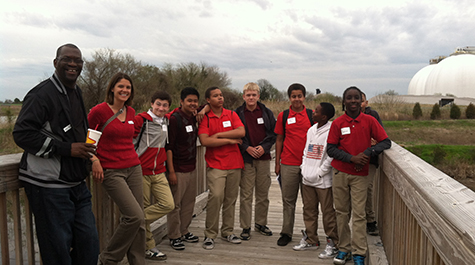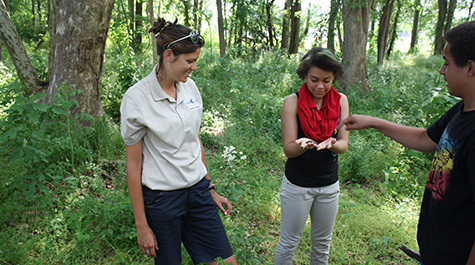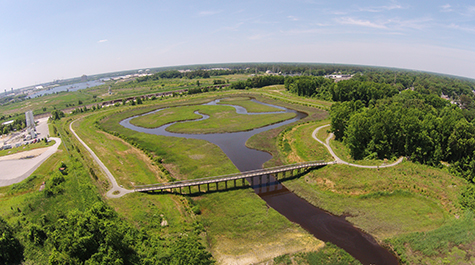VIMS alumna brings environmental education to urban river
The Elizabeth River Project has placed an alumna of the Virginia Institute of Marine Science at the forefront of their latest effort to restore the iconic Elizabeth River.
Sarah Sumoski, a 2012 graduate of William & Mary’s School of Marine Science at VIMS, is the new Recreation and Education Programs Manager for Paradise Creek Nature Park—a 40-acre waterfront park in Portsmouth built to teach current and future generations what it takes to restore the health of an urban river.
A tributary of Chesapeake Bay, the Elizabeth River was long infamous due to its high levels of pollution from creosote plants and other industrial operations. Opened in 2013, Paradise Creek Nature Park is a shining example of the river’s ongoing revitalization, using newly created wetlands, a forest trail, and public programs to help local residents and visitors appreciate the river’s rebirth.
The Elizabeth River Project—a citizen-led non-profit—developed the park in collaboration with the City of Portsmouth and the Virginia Port Authority. When faced with finding the right person to bring awareness to the troubled river, Sumoski was chosen to help spread the word that cleanup efforts are slowly but surely bringing the waterway back to life.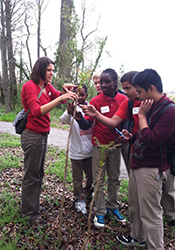
Sumoski says she’s excited to be teaching people about the environment and getting the word out about conservation. “There’re a lot of people in the area who have never experienced being in the woods or on the beach, so I’m really enjoying working with the public and raising awareness,” she says.
Sumoski has been striving to develop engaging and educational environmental programs since joining the park staff in 2013. The park now boasts an assortment of tours and activities, from mini-safaris to full-moon walks, all of which she created and now leads.
Sumoski’s background in research and education helps her bring a unique perspective to park operations. Before completing her Master’s degree at VIMS, Sumoski earned a Bachelor’s degree in Conservation Biology from the State University of New York’s College of Environmental Science and Forestry in Syracuse, where she also taught environmental programs during summer camps. She’s also served as an urban park ranger and led public programs in Central Park and Inwood Hill Park in Manhattan.
Sumoski came to VIMS in 2009 to pursue her Master’s under the guidance of VIMS Professor Robert (J.J.) Orth. Her research focused on eelgrass restoration in Chesapeake Bay and Virginia’s Coastal Bays. Eelgrass—like other seagrasses—is a flowering plant that reproduces both by sending out rhizomes (like crabgrass) and producing tiny underwater seeds. Eelgrass beds play a key ecological role in Chesapeake Bay and other coastal ecosystems, but are in decline worldwide due to cloudy waters, warm temperatures, and excess nutrients that encourage the growth of light-stealing algae.
While at VIMS, Sumoski published a study of seed dispersal in the eelgrass beds of Chesapeake Bay. The study—the first to show that marine animals can disperse eelgrass seeds—appeared as the featured article for the December 2012 issue of Marine Ecology Progress Series.
Orth describes Sumoski as a model student who was a motivated and hard-working part of VIMS’ seagrass team. “Sarah was a very dedicated student who contributed to our understanding of seagrass dispersal processes with her pioneering work on biotic dispersal of eelgrass seeds,” he says. “She wanted to make a difference in the environmental field by using her knowledge gained at VIMS to better educate the public, and now she is getting that opportunity.”
“The education and experience I gained at VIMS has helped me immensely in educating others about the environment, especially in and around Chesapeake Bay,” says Sumoski. “I’m always tying what I learned as a graduate student into my lessons as an urban park ranger.”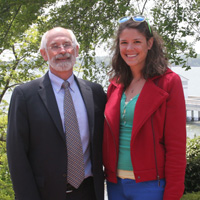
A self-proclaimed extremist, Sumoski says she’s most comfortable in either rural areas or big cities. “I know they’re two very different extremes, but that’s where I am happiest,” she says. “My ultimate dream would be to be the Director of Parks and Recreation for New York City because I feel like I would get the best of both of those extremes.”
A lover of urban parks, Sumoski says she is excited to be bringing outdoor environmental education programs to Portsmouth. “There are many people in this community who haven’t had the opportunity to interact with nature, so I love enlightening them to the environment,” she says. “It’s so rewarding to see them learning and interacting with nature.”
Paradise Creek Nature Park provides the opportunity to enjoy a restored Elizabeth River first-hand. The park—home to more than 188 species of birds, fish, and other wildlife—is thriving with new wetlands and a revitalized forest, and is a shining example of a revitalized river shoreline.
The Elizabeth River Project’s overall mission is to restore the river to the highest practical level of environmental quality through government, business, and community partnerships. Started in 1991, the Elizabeth River Project is leading community efforts to ensure the river will be swimmable and fishable in all practical reaches by 2020.
VIMS scientists have been actively involved in efforts to identify and remediate the river’s problem spots, including groundbreaking studies of liver cancer in mummichog fishes exposed to organic pollutants, and experimental use of biosensors to guide the removal and containment of contaminated sediments.


